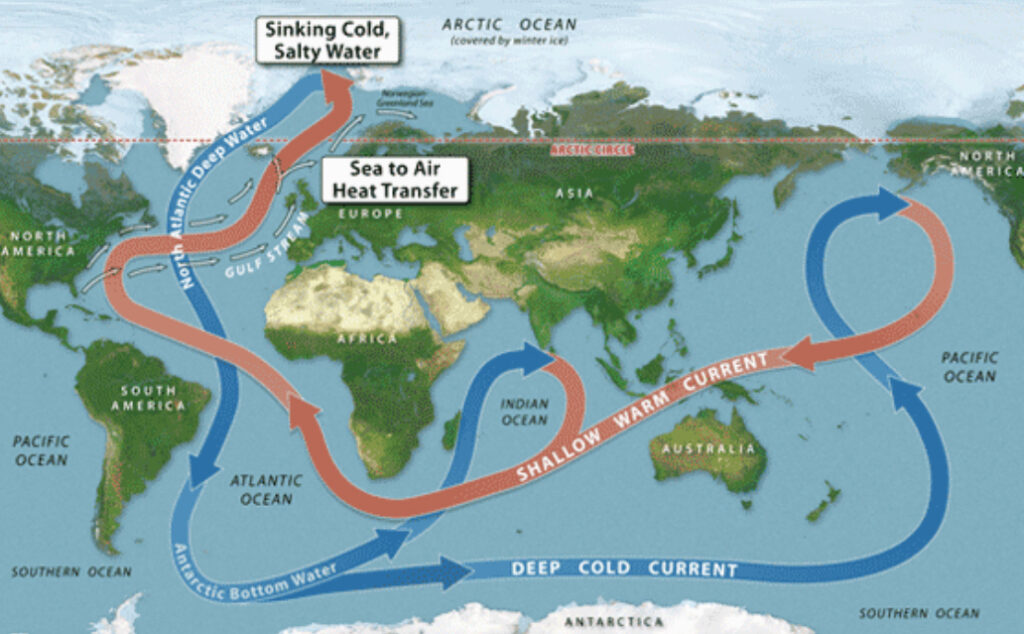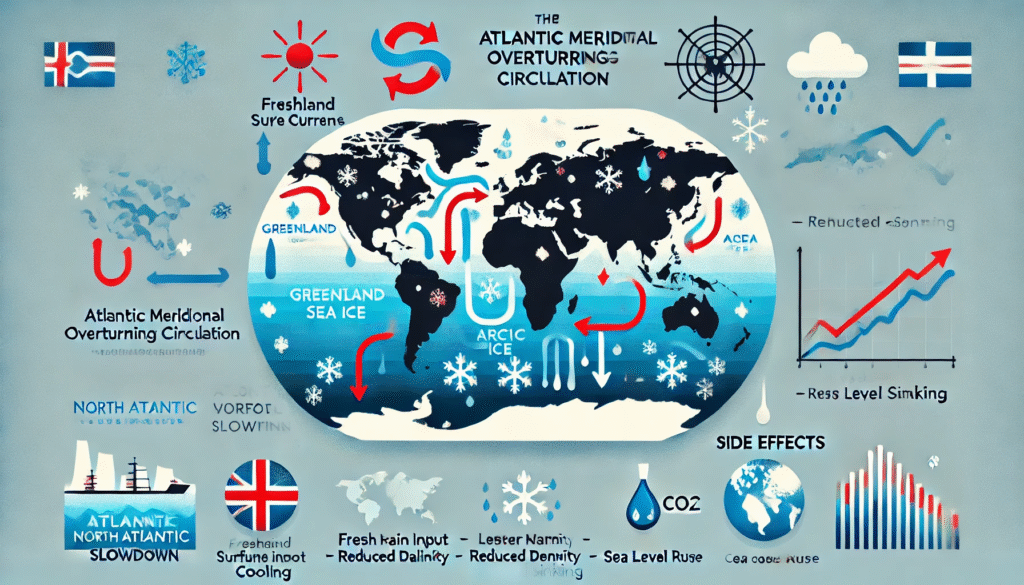
ChatGPT:
The Thermohaline Circulation: Earth’s Slow-Moving Climate Engine
Earth’s oceans are not just vast bodies of water; they are dynamic engines that regulate heat, carbon, and weather across the globe. At the heart of this system lies the thermohaline circulation (THC), sometimes called the global conveyor belt. Driven by density differences in seawater — controlled by both temperature (thermo) and salinity (haline) — this circulation connects all the major ocean basins in a cycle that takes roughly 1000 years to complete. Though it moves at a glacial pace compared to wind-driven surface currents, its role in climate is profound, providing Earth with long-term stability but also creating significant inertia in how the climate responds to change.
This essay explores why the deep ocean is cold, how polar waters sink, why the circulation takes so long, what controls the speed of sinking, and why the system is slowing today under climate change.
Why the Deep Ocean Is So Cold
At first glance, it may seem obvious that the deep ocean is cold simply because sunlight does not penetrate that far. But that only explains why the ocean depths do not warm — it doesn’t explain how they became so cold in the first place.
The answer lies in the polar regions. In the North Atlantic near Greenland and in the Southern Ocean around Antarctica, seawater is cooled to near-freezing. When sea ice forms, salt is expelled in a process called brine rejection, which makes the surrounding liquid water saltier and denser. In some cases, evaporation by strong polar winds further increases salinity. The combination of near-freezing temperatures and high salinity makes the water so dense that it sinks, plunging rapidly to depths of 2000–4000 meters.
Once there, this water retains its cold temperature because there are no significant heat sources at depth. Unlike the atmosphere, which mixes constantly, the deep ocean has limited vertical mixing. Thus, water sinking in polar regions “remembers” its initial temperature for centuries. This is why the deep Pacific and Indian Oceans, far from the poles, still carry the cold fingerprint of water last exposed to the atmosphere hundreds of years ago.
The Thermohaline Conveyor Belt
The sinking of dense polar waters acts as a pump that drives the global circulation system. This process is called thermohaline circulation because it depends on both temperature and salinity.
- In the North Atlantic, dense water forms North Atlantic Deep Water (NADW), which flows southward along the bottom of the Atlantic Ocean.
- Around Antarctica, even colder and denser water forms Antarctic Bottom Water (AABW), which spreads into the world’s ocean basins.
- These deep currents slowly fill the Indian and Pacific Oceans, where they gradually upwell due to wind-driven mixing and turbulence.
- Finally, the waters return to the surface and begin the journey back toward the Atlantic, closing the loop.
This circulation is sometimes called the Great Ocean Conveyor Belt because of its global reach. Remarkably, it takes about 1000 years for a parcel of water to travel the entire loop — a timescale that gives Earth’s climate a long “memory.”
Why the Circulation Is So Slow
If water can sink rapidly in polar regions, why does it take centuries to complete the cycle? Several factors explain the slowness of thermohaline circulation:
- Weak Driving Force: Unlike wind-driven surface currents that move at speeds of kilometers per day, deep currents are propelled only by tiny density differences. Their speeds are measured in centimeters per second, meaning they creep across basins.
- Vast Distances: The oceans cover 71% of Earth’s surface and average 3.7 km deep. Water traveling from the North Atlantic to the Pacific must cross tens of thousands of kilometers.
- Seafloor Topography: Deep currents cannot move in straight lines; they must weave around ridges, trenches, and seamounts, slowing their progress.
- Slow Upwelling: The return journey to the surface happens through diffuse upwelling in the Pacific and Indian Oceans. Upwelling occurs at rates of millimeters to centimeters per day, meaning centuries before water resurfaces.
Together, these factors ensure that the conveyor belt takes roughly 1000 years to complete one cycle.
How Fast Do Polar Waters Sink?
Interestingly, while the global journey is slow, the actual sinking of dense water in polar regions is relatively rapid.
- Once water becomes denser than the layer below, it plunges through the water column in days to weeks, reaching depths of thousands of meters.
- Vertical velocities in convection chimneys have been measured at 10–100 meters per day.
- This process is accelerated by storm-driven turbulence and strong winter cooling.
Thus, the “entry” of water into the conveyor belt is almost instantaneous in climate terms, even though the subsequent circulation is sluggish.
What Controls the Speed of Sinking?
The rate and strength of sinking in the North Atlantic and around Antarctica depend on several factors:
- Density Contrast: The greater the density difference between surface and subsurface water, the faster the sinking.
- Salinity Increases: Brine rejection during ice formation and evaporation both raise salinity, enhancing sinking.
- Cooling Rate: Harsh winters and strong winds remove heat quickly, boosting density.
- Stratification: If underlying waters are strongly stratified, sinking slows; if they are already dense, sinking is easier.
- Freshwater Input: Meltwater from Greenland, Arctic rivers, or Antarctic ice shelves dilutes salinity and prevents sinking.
This delicate balance explains why some winters see intense deep convection in the Labrador Sea, while in other years, sinking nearly stops.
Why the Conveyor Is Slowing Down Today
Recent observations and climate models show that the Atlantic Meridional Overturning Circulation (AMOC) — the North Atlantic branch of thermohaline circulation — is weakening and may now be at its lowest strength in over 1000 years.
The causes are directly tied to climate change:
- Greenland Ice Sheet Melt: Vast amounts of freshwater are pouring into the North Atlantic, reducing salinity.
- Arctic Sea Ice Melt: Seasonal melt adds additional fresh water.
- Increased Rainfall and River Runoff: A stronger hydrological cycle delivers more freshwater into the North Atlantic.
- Surface Warming: Warmer waters are less dense, acting like a lid that prevents sinking.
With reduced salinity and warming, surface waters are less able to sink, weakening the entire conveyor.
Consequences of Slowdown
A slowdown of the conveyor has profound impacts:
- Europe: Paradoxically, Northern Europe could cool even as global temperatures rise, because less heat is transported northward.
- Tropics: Rain belts could shift, leading to droughts in Africa and South America.
- North America: Sea levels could rise faster on the U.S. East Coast as water “piles up” when deep currents weaken.
- Global Carbon Cycle: Less carbon would be stored in the deep ocean, accelerating atmospheric CO₂ buildup.
This is why the thermohaline circulation is often called Earth’s “Achilles’ heel” of the climate system — a fragile but critical regulator.
Conclusion
The thermohaline circulation is one of Earth’s most important yet slowest processes. Fueled by the sinking of cold, salty waters in the polar regions, it distributes heat and carbon across the globe on millennial timescales. While the sinking itself occurs in days to weeks, the journey of deep water across the oceans takes about 1000 years, due to weak driving forces, immense distances, friction with seafloor topography, and sluggish upwelling.
The strength of this system depends on a delicate balance of cooling, salinity, and freshwater input. Today, climate change is tipping that balance, with Greenland meltwater, sea ice loss, and warming seas slowing the North Atlantic conveyor. If the slowdown continues, the impacts could reshape weather, monsoons, sea levels, and carbon storage worldwide.
The oceans give Earth climate stability — but they also remind us that what we do today will echo for centuries, carried slowly but surely by the great conveyor belt of the deep.

